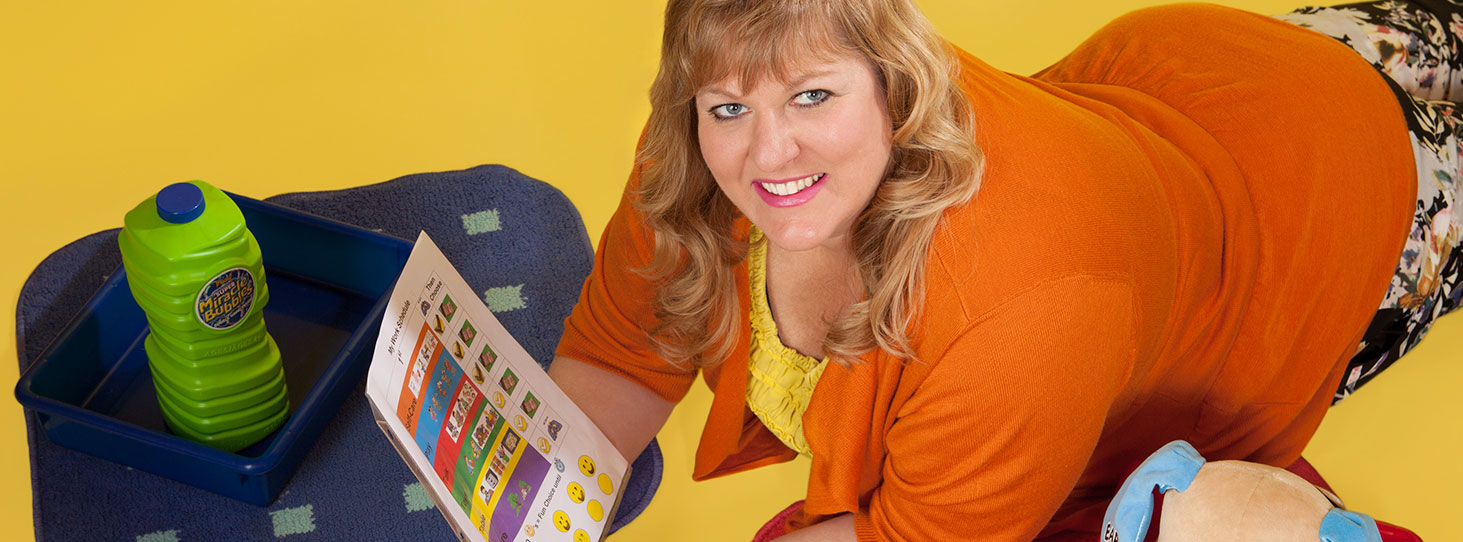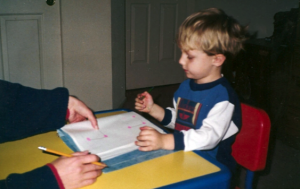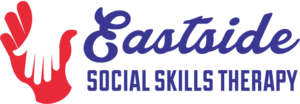
Meet our Founder
In 1993 my oldest son, John, was diagnosed with Pervasive Developmental Disorder, not Otherwise Specified (PDD/NOS). He was three years old at the time and appeared to be regressing with speech, and loss of eye contact, and wasn’t playing with other children. He had a lot of repetitive behaviors and was difficult to manage, especially during times of transition. In 1994 we had him re-evaluated by another doctor who diagnosed him with Autistic Disorder. In addition to these diagnoses my son also received many more as he grew up. As the years went by, we discovered a variety of medical conditions through genetic testing, EKGs, EEGs, MRIs, and blood work. The number of doctor appointments and treatments was overwhelming, and I truly know what parents are going through whose children are being diagnosed with Autism Spectrum Disorder (ASD) and other medical conditions today. Not only was I overwhelmed by feeling the pressures to search for a cure, but I also felt a huge sense of guilt wondering where this condition came from and how did it happen? My pregnancy was perfect. I ate all the right foods, followed all of the doctor’s directions, and didn’t have any issues during delivery. John was a healthy little boy. For his first few years, he seemed perfectly normal to me. As a mother, I felt compelled to search for answers. I also realized that my son needed help learning new skills and the sooner the better.

At the time of my son’s initial ASD diagnosis, we decided to start an Early Intensive Behavioral Intervention (EIBI) program to teach him how to talk, play, and become independent at home. A team from UCLA supervised by Dr. O Ivar Lovaas, Ph.D. came to my home to train me and the staff that I had gathered to work with my son. They developed a Treatment Plan and they taught us the principles of Applied Behavior Analysis (ABA) and showed us how to use these principles to manage my son’s behaviors so that he can learn new skills.
We became one of the first Home Programs run by parents using ABA to treat children with autism. An organization named Families for Early Autism Treatment (FEAT) was formed in Sacramento, CA during that same time and we were able to receive grant funding to pay for the UCLA training through this non-profit organization. I became very involved, even writing and developing the first Parent Handbook and Resource Guide for new members of FEAT. For two years I ran monthly parent resource meetings and I got involved with fund-raising by joining committees, planning dinner auctions, and other events. I made new friends and by connecting with other parents I was able to get the emotional support that I needed to get through the toughest of times. I am forever grateful for the FEAT organization and for those parents before me who wrote that original FEAT grant so that my son could get the treatment that he needed. We happened to be at the right place at the right time and I feel so fortunate. Today children are receiving ABA services through their medical insurance and school districts, and I can tell you that it has been a long journey over the years to get these services available to the general public. I was there in the beginning and have watched the evolution of this treatment go from being one published study out of UCLA to an entire field of practice offered by our medical community with thousands of licensed professionals around the world now providing this service.
So, what was it like for myself and my son? For two years we ran a home program for John 40 hours a week. He worked Monday through Friday from 8:00 AM – 6:00 PM with a two-hour break at noon for lunch and a nap. His treatment team worked in two-hour shifts which was a combination of him working at a small table doing discrete trials with short breaks on the floor playing with toys and then longer breaks outside between team member’s shifts. He worked on language, play, academics, and self-care. He learned to talk, ride a bike, play with toys, play with peers, and one year into therapy he attended a private preschool program a few mornings a week with one of his team members to ensure that he was participating and generalizing the skills that we had taught him at home into a classroom setting. Most of all, the behavior technician was there to ensure that he was following the group instruction by the teacher and was playing with the kids. By the time my son was six years old, he was reading on a first-grade level, doing double-digit subtraction with borrowing, talking up a storm, and playing rollerblade hockey on our street with all the kids in the neighborhood. The day my son was included in general education kindergarten was one of the happiest days of my life. I remember how nervous I was feeling wondering if other parents or children would notice that there was something different about my son. He wasn’t 100% normal, but his IQ score was raised to normal levels, and he was able to participate in general education and that was all that mattered to me. I was so proud of how far he had come and how much he had learned from his ABA program. I think, for him, one of his happiest days was when he was invited to go to AJ’s birthday party at Burger King. He talked about it for years afterward because he had made a friend at school, and he felt special when they gave him a party bag to bring home. It’s these little moments that mattered the most to him.
Everything that we had taught John from the intensive early intervention set him up for success in school and I do believe that my involvement in his treatment was a key factor in his success, because I could take every skill that was being taught to him by his team and generalize it into his natural environment. I attended every team meeting and educated myself on how I could change what I do as a parent so that I could help my son learn and grow. I can’t imagine where he would have been had we not intervened when we did. This is what inspired me to make a career change and to take what I had learned from my son and help others have similar results. I had initially worked as a computer programmer analyst in the late 1980s and early 1990s and earned a Bachelor of Science degree in Business Administration with an emphasis in Information Systems and Decision Sciences from San Diego State University in 1987. After working in the field of information technology for 7 years, I decided to become a stay-at-home mom and focus my attention on my children’s needs. I raised three sons in the Issaquah School District where I spent hours volunteering my time in my sons’ classrooms and supporting their sports and other after-school activities. In 2005, I decided it was time to return back into the workforce and I started working in the field of ABA providing services to young children as a behavior technician and was under the supervision of multiple Board Certified Behavior Analysts (BCBA) in Seattle and surrounding areas. I learned so much from my mentors and loved working with the families. Helping them and watching the children learn and grow just melts my heart and gets me excited about their futures. I always say, “I have the best job in the world because I get paid to play.” That’s exactly how it feels on most days, although doing this work is a lot harder than it may appear.
Being the naturally ambitious person that I am, I decided to go back to college and become a Board Certified Behavior Analyst myself and start my own company focused on intensive early behavior intervention as we did with my son. I graduated with a Master of Education from the University of Washington in 2009 and started Eastside Social Skills Therapy, PLLC in Issaquah, WA in January 2010.
Being in this field of practice and meeting other providers of service for so many years, I have witnessed firsthand how effective Applied Behavior Analysis (ABA) intervention, especially at an early age, can be if managed by the right people. This has made me even more dedicated, strong-minded, and passionate about the treatment programs we offer our clients. I now have a very strong scientific and analytical background with over 30 years of experience. Not many ABA business owners can say this, nor can they say that they are also a parent of a child on the autism spectrum. Now that I am a Licensed Behavior Analyst in the state of Washington, I am personally dedicated to staying current on the science and research related to ABA and Autism Spectrum Disorder.
I have personally navigated through false prophets who feed off of vulnerable parents of newly diagnosed children and nothing angers me more than to see a naïve parent buying into false promises of a cure through frauds seeking to make a profit for their own businesses selling products and treatments that have not been researched and/or proven to be effective. It distracts parents’ attention away from what really matters and it drains them of their finances and sets them up emotionally to fail. The guilt parents feel for not trying everything can be emotionally taxing on a family. Applied Behavior Analysis is currently considered the most effective treatment for children with autism and through my own firsthand experiences with my son and my business, I am a big believer in its effectiveness. With that said, I do want to be clear that ABA is not a cure or a quick fix. It is expensive. It’s hard work and it isn’t something every parent can handle and not all children make as much progress as my son did. Autism Spectrum Disorder affects each child differently and some are more severely affected than others. I believe every child can learn something new and ABA intervention at an early age is the best way to set your child up for success.
I’d also like to add that although I was searching for a cure when my son was younger, I discovered over time that there is no cure for autism. It’s not a disease or something that needs to be fixed. It’s a condition and a way of being much like a personality. No two people with autism are alike and I believe there are many different causes. Some can be genetic, and some can be environmental or a combination of both. People with autism process information differently and they learn differently. Placing a toddler with autism in a classroom setting and expecting them to learn new things by group instruction just isn’t the right way to help them. Working with them 1:1 and breaking things down into simple steps that they can follow and be successful is what will motivate them to want to do more, Knowing how to motivate the child to try new things is the power behind why the science of ABA is so effective. Once early intervention has begun and the child is learning, then the next step would be to move them into a group setting that will eventually prepare the child to learn in a kindergarten classroom. In other words, there is no rush to place a young child with autism in a school setting. They will be in school for the next 12+ years of their life. What is important during the toddler and preschool years is to teach them all you can to prepare them for their years in school and long after.
I am living my dream of working with the autism population and I take a lot of pride in ensuring that each child progresses in a forward direction with positive results. I especially love meeting the parents and guiding them through this world of special needs that is full of rules, laws, love, tears, and laughter. My life is not what I had planned for myself. It’s better and I am better because of all the challenges that I have overcome as a mother of a child with special needs.
Penny Lathum, M.Ed., BCBA, LBA
Board Certified Behavior Analyst – #1-10-7087
Owner/Director of Eastside Social Skills Therapy, LLC
